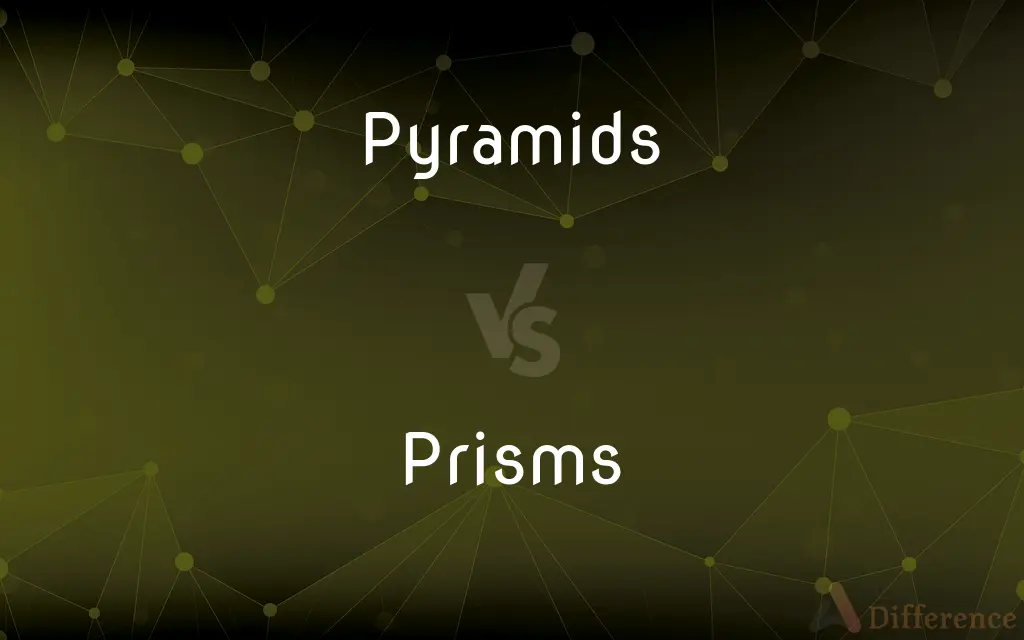Pyramids vs. Prisms — What's the Difference?
Edited by Tayyaba Rehman — By Fiza Rafique — Published on November 25, 2023
Pyramids are 3D shapes with a polygonal base converging to an apex, while prisms have two parallel polygonal bases connected by rectangular or parallelogram sides. Both are polyhedrons.

Difference Between Pyramids and Prisms
Table of Contents
ADVERTISEMENT
Key Differences
Pyramids are three-dimensional shapes that start with a polygonal base and taper off to a singular point known as the apex. In contrast, prisms are also three-dimensional figures, but they boast two parallel polygonal bases. The sides of prisms are either rectangles or parallelograms, ensuring that the two bases remain parallel.
Each pyramid, regardless of its base's shape, eventually converges to one point: the apex. Prisms, meanwhile, maintain a uniform cross-section throughout their length, thanks to the parallel nature of their bases.
The number of faces on pyramids is determined by the polygon that forms its base. For instance, a pyramid with a triangular base will have four faces in total. Prisms, on the other hand, have as many faces as there are sides to the base plus two for the bases themselves.
One of the most notable examples of pyramids is the ancient Egyptian Pyramids, built as monumental structures. Prisms are more commonly seen in day-to-day life, especially in the form of rectangular prisms like boxes or books.
The volume of both pyramids and prisms is contingent upon the area of their base. For pyramids, the volume is one-third the product of the base area and height, whereas for prisms, it's the direct product of base area and height.
ADVERTISEMENT
Comparison Chart
Shape
Tapers to a point (apex).
Maintains a consistent cross-section.
Bases
One polygonal base.
Two parallel polygonal bases.
Faces
Base + 1 (due to the apex).
Number of base sides + 2 (the bases).
Volume Formula
⅓ × base area × height.
Base area × height.
Common Examples
Egyptian Pyramids.
Boxes, books.
Compare with Definitions
Pyramids
3D shapes with a single polygonal base tapering to an apex.
The Great Pyramids of Giza are examples of square-based pyramids.
Prisms
Volume is the direct product of the base area and height.
A cereal box, being a rectangular prism, has a volume found by multiplying its length, width, and height.
Pyramids
Structures with faces sloping to a common point.
The food pyramid visualizes nutritional needs.
Prisms
Polyhedrons with faces that are parallelograms.
Prisms are commonly seen in optical instruments.
Pyramids
Can have triangular, square, or other polygonal bases.
The Louvre Museum has a glass pyramid with a square base.
Prisms
Maintains a consistent cross-sectional shape along its length.
When sliced perpendicular to its bases, prisms produce slices that match the base shape.
Pyramids
A monumental edifice with a square or triangular base.
The Mayans also built pyramids, but with steeper sides.
Prisms
3D shapes with two parallel, congruent polygonal bases.
Glass prisms can split white light into a spectrum of colors.
Pyramids
Volume is one-third of the product of base area and height.
Calculating the volume of pyramids requires knowledge of the base area.
Prisms
Used in optics to refract light.
Prisms in binoculars can invert and reverse images.
Pyramids
A solid figure with a polygonal base and triangular faces that meet at a common point.
Prisms
A solid figure whose bases or ends have the same size and shape and are parallel to one another, and each of whose sides is a parallelogram.
Pyramids
Something shaped like this polyhedron.
Prisms
A transparent body of this form, often of glass and usually with triangular ends, used for separating white light passed through it into a spectrum or for reflecting beams of light.
Pyramids
A massive monument of ancient Egypt having a rectangular base and four triangular faces culminating in a single apex, built over or around a crypt or tomb.
Prisms
A cut-glass object, such as a pendant of a chandelier.
Pyramids
Any of various similar constructions, especially a four-sided Mesoamerican temple having stepped sides and a flat top surmounted by chambers.
Prisms
A crystal form consisting of three or more similar faces parallel to a single axis.
Pyramids
The transactions involved in pyramiding stock.
Prisms
A medium that misrepresents whatever is seen through it.
Pyramids
(Anatomy) A structure or part suggestive of a pyramid in shape.
Prisms
Plural of prism
Pyramids
To place or build in the shape of a pyramid.
Pyramids
To build (an argument or thesis, for example) progressively from a basic general premise.
Pyramids
To speculate in (stock) by making a series of buying and selling transactions in which paper profits are used as margin for buying more stock.
Pyramids
To assume the shape of a pyramid.
Pyramids
To increase rapidly and on a widening base.
Pyramids
To pyramid stocks.
Pyramids
Plural of pyramid
Pyramids
The game of pyramid pool.
Pyramids
Infl of pyramid
Common Curiosities
Can pyramids have bases other than triangles?
Yes, pyramids can have square, pentagonal, or other polygonal bases.
Are the Egyptian pyramids the only examples of pyramids?
No, pyramids exist in various cultures, like Mayan pyramids. The term also refers to the geometric shape, not just monumental structures.
How many faces does a rectangular prism have?
It has six faces: four rectangles and two squares or rectangles, depending on the prism.
Are all the sides of a prism always rectangles?
No, prisms can have sides that are parallelograms, especially if the bases are not rectangles.
Are prisms used in everyday life?
Yes, prisms are seen in optics, like binoculars, and everyday shapes like boxes.
Can a pyramid's base be a circle?
No, that would be a cone. Pyramids have polygonal bases.
Can a pyramid's apex be off-center?
Yes, in an oblique pyramid, the apex isn't directly above the base's center.
How many faces does a triangular pyramid have?
It has four faces: three triangular sides and a triangular base.
What's the fundamental shape difference between pyramids and prisms?
Pyramids taper to a singular point, the apex, while prisms have two parallel bases with a consistent cross-section.
How is the volume of pyramids and prisms calculated?
For pyramids, it's ⅓ × base area × height; for prisms, it's base area × height.
Is a cube a type of prism?
Yes, a cube is a special type of rectangular prism where all sides are equal.
Can prisms have bases other than rectangles or squares?
Yes, prisms can have triangular, pentagonal, or other polygonal bases.
Why do pyramids and prisms belong to the polyhedron family?
Both have flat, polygonal faces and straight edges, defining characteristics of polyhedrons.
What's the main purpose of optical prisms?
Optical prisms can refract, reflect, and disperse light, often used in instruments to manipulate light paths.
What's the cross-section of a prism?
When cut perpendicular to its bases, the cross-section of a prism matches its base shape.
Share Your Discovery

Previous Comparison
Zeeman Effect vs. Stark Effect
Next Comparison
Puppet vs. Puppet EnterpriseAuthor Spotlight
Written by
Fiza RafiqueFiza Rafique is a skilled content writer at AskDifference.com, where she meticulously refines and enhances written pieces. Drawing from her vast editorial expertise, Fiza ensures clarity, accuracy, and precision in every article. Passionate about language, she continually seeks to elevate the quality of content for readers worldwide.
Edited by
Tayyaba RehmanTayyaba Rehman is a distinguished writer, currently serving as a primary contributor to askdifference.com. As a researcher in semantics and etymology, Tayyaba's passion for the complexity of languages and their distinctions has found a perfect home on the platform. Tayyaba delves into the intricacies of language, distinguishing between commonly confused words and phrases, thereby providing clarity for readers worldwide.













































